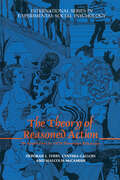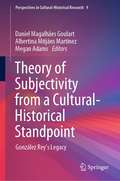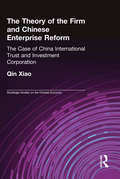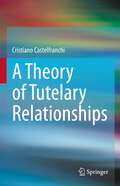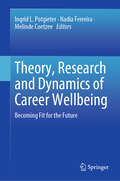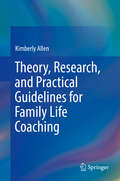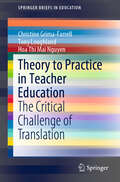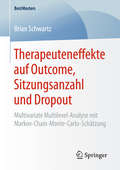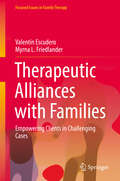- Table View
- List View
The Theory of Reasoned Action: Its application to AIDS-Preventive Behaviour (International Series in Social Psychology)
by Deborah J. Terry Cynthia Gallois Malcolm McCamishThe Theory of reasoned action explores the theory and emphirical reserach in to the factors which influence whether people engage in high-risk practices , with specific reference to AIDS education.
The theory of reasoned action (Large Print)
by Rnib BookshareThis is a flow chart diagram and consists of four boxes and four arrows. There is a locator dot shown, which will be at the top left of the page when the image is the right way up. It shows the factors influencing reasoned action. It has four labelled boxes linked by arrows, and reads generally from left to right. However, one arrow is multi-directional, and the arrows can link boxes vertically and horizontally.
The theory of reasoned action (UEB Contracted)
by Rnib BookshareThis is a flow chart diagram and consists of four boxes and four arrows. There is a locator dot shown, which will be at the top left of the page when the image is the right way up. It shows the factors influencing reasoned action. It has four labelled boxes linked by arrows, and reads generally from left to right. However, one arrow is multi-directional, and the arrows can link boxes vertically and horizontally.
The theory of reasoned action (UEB Uncontracted)
by Rnib BookshareThis is a flow chart diagram and consists of four boxes and four arrows. There is a locator dot shown, which will be at the top left of the page when the image is the right way up. It shows the factors influencing reasoned action. It has four labelled boxes linked by arrows, and reads generally from left to right. However, one arrow is multi-directional, and the arrows can link boxes vertically and horizontally.
A Theory of Subjective Wellbeing (Philosophy, Politics, and Economics)
by Mark FabianThe study of 'subjective wellbeing' has seen explosive growth in recent decades, opening important new discourses in personality and social psychology, happiness economics, and moral philosophy. Now it is moving into the policy domain. In this it has arguably overstepped its limits. The shallow theoretical base of subjective wellbeing research, the limitations of its measurement instruments, and its ethical naivety makes policymaking on the basis of its findings a risky venture. The present volume is an attempt to shore up these weaknesses and set subjective wellbeing scholarship on a course for several more decades of growth and maturity. It presents a theory of subjective wellbeing in two parts. The first is the subjective wellbeing production function-a model of wellbeing as outcome. The second is the coalescence of being: a model of the self-actualisation process by which wellbeing is achieved. This two-part model integrates not only ideas in SWB studies and analytical philosophy, but also ideas from clinical, moral, and developmental psychology, continental philosophy, and welfare economics. Importantly, this theory is ethically sensitive, bridging the gap between psychological and philosophical perspectives on wellbeing that illuminates the complexities facing the application of subjective wellbeing in public policy. The book also provides a thorough review of various ways complex theories of subjective wellbeing can be studied empirically, and the hard trade offs between long surveys that capture the richness of the concept and the short surveys that are feasible in the context of social surveys and policy analysis.
A Theory of Subjective Wellbeing (Philosophy, Politics, and Economics)
by Mark FabianThe study of 'subjective wellbeing' has seen explosive growth in recent decades, opening important new discourses in personality and social psychology, happiness economics, and moral philosophy. Now it is moving into the policy domain. In this it has arguably overstepped its limits. The shallow theoretical base of subjective wellbeing research, the limitations of its measurement instruments, and its ethical naivety makes policymaking on the basis of its findings a risky venture. The present volume is an attempt to shore up these weaknesses and set subjective wellbeing scholarship on a course for several more decades of growth and maturity. It presents a theory of subjective wellbeing in two parts. The first is the subjective wellbeing production function-a model of wellbeing as outcome. The second is the coalescence of being: a model of the self-actualisation process by which wellbeing is achieved. This two-part model integrates not only ideas in SWB studies and analytical philosophy, but also ideas from clinical, moral, and developmental psychology, continental philosophy, and welfare economics. Importantly, this theory is ethically sensitive, bridging the gap between psychological and philosophical perspectives on wellbeing that illuminates the complexities facing the application of subjective wellbeing in public policy. The book also provides a thorough review of various ways complex theories of subjective wellbeing can be studied empirically, and the hard trade offs between long surveys that capture the richness of the concept and the short surveys that are feasible in the context of social surveys and policy analysis.
Theory of Subjectivity from a Cultural-Historical Standpoint: González Rey’s Legacy (Perspectives in Cultural-Historical Research #9)
by Daniel Magalhães Goulart Albertina Mitjáns Martínez Megan AdamsThis book examines key ideas related to the Theory of Subjectivity within a cultural-historical approach. It brings together the intellectual contributions made by Professor Fernando González Rey (1949–2019) towards understanding human subjectivity, and emphasizing their unfolding in different fields and contexts. The book addresses the genesis and development of González Rey’s work, articulating this discussion with the author’s biography. González Rey’s main scientific contribution is the Theory of Subjectivity in a cultural-historical perspective, which is inseparable from Qualitative Epistemology and from its constructive-interpretive methodological expression. The book presents and discusses González Rey’s contributions to different contexts and fields, such as psychological research, education, cultural-historical psychology, human development, motivation, human health and psychotherapy. This book brings together examples of how these ideas have been employed and developed in different fields and contexts.
A Theory of System Justification
by John T. JostA leading psychologist explains why nearly all of us—including many of those who are persecuted and powerless—so often defend the social systems that cause misery and injustice. Why do we so often defend the very social systems that are responsible for injustice and exploitation? In A Theory of System Justification, John Jost argues that we are motivated to defend the status quo because doing so serves fundamental psychological needs for certainty, security, and social acceptance. We want to feel good not only about ourselves and the groups to which we belong, but also about the overarching social structure in which we live, even when it hurts others and ourselves. Jost lays out the wide range of evidence for his groundbreaking theory and examines its implications for our communities and our democracy. Drawing on twenty-five years of research, he provides an accessible account of system justification theory and its insights. System justification helps to explain deep contradictions, including the feeling among some women that they don’t deserve the same salaries as men and the tendency of some poor people to vote for policies that increase economic inequality. The theory illuminates the most pressing social and political issues of our time—why has it been so hard to combat anthropogenic climate change?—as well as some of the most intimate—why do some black children prefer white dolls to black ones and why do some people stay in bad relationships? Jost’s theory has far-reaching implications, and he offers numerous insights that political activists and social justice advocates can use to promote change.
The Theory of the Firm and Chinese Enterprise Reform: The Case of China International Trust and Investment Corporation (Routledge Studies on the Chinese Economy)
by Xiao QinChanges to corporate structure, including the role of the corporate headquarters, have been key factors in bringing about economic reform in China. In this penetrating and insightful book, Xiao questions the conventional theory of the firm, arguing that the ultimate goal of the headquarters of modern large corporations is to function as a substitute for the market, and introducing a new explanation for the nature of the firm - the 'substitution function model'. He provides an insider's account of the reforms in CITIC, a rare narrative that should be essential reading for scholars and practitioners who care about the theory and practice of the firm, in particular in the context of Chinese enterprise reform.
The Theory of the Firm and Chinese Enterprise Reform: The Case of China International Trust and Investment Corporation (Routledge Studies on the Chinese Economy)
by Xiao QinChanges to corporate structure, including the role of the corporate headquarters, have been key factors in bringing about economic reform in China. In this penetrating and insightful book, Xiao questions the conventional theory of the firm, arguing that the ultimate goal of the headquarters of modern large corporations is to function as a substitute for the market, and introducing a new explanation for the nature of the firm - the 'substitution function model'. He provides an insider's account of the reforms in CITIC, a rare narrative that should be essential reading for scholars and practitioners who care about the theory and practice of the firm, in particular in the context of Chinese enterprise reform.
A Theory of Tutelary Relationships
by Cristiano CastelfranchiThe purpose of the book is to propose and exploit an analytical, critical, well defined theory of a very crucial human social relation that I call “Tutelarity/ Tutelage”. This will thus explain how/why such relation is so relevant at any layer of sociality: from affective relationships, to social cooperation and interactions, to politics and democracy. The approach is theoretical and strongly grounded on cognitive science and the models of human mind: beliefs, desires, expectations, emotions, etc. Written in an accessible way, it will be of interest for a large audience, specifically to researchers and scientists interested in cognitive science and the dynamics of social relationships alike.
Theory, Research and Dynamics of Career Wellbeing: Becoming Fit for the Future
by Ingrid L. Potgieter Nadia Ferreira Melinde CoetzeeThis volume offers a new conceptualization of career wellbeing by viewing the construct as an individual’s long-term contentment with their career outcomes, career achievements, career changes and their sustainable employability amidst the complexities of the contemporary and emerging future digital-driven work environment. In support of this view of career wellbeing, the volume constructs theoretical frameworks for “future-fit” career wellbeing in the digital-driven work–life context. The chapters juxtaposition current research trends in terms of future potential directions for research on career wellbeing in Industry 4.0. The volume also critically evaluates the relevance, applicability and utility of the research findings and theoretical premises in various current versus potential Industry 4.0 settings for individuals across the life-span. It offers valuable suggestions for practice and interventions.
Theory, Research, and Practical Guidelines for Family Life Coaching
by Kimberly AllenThis volume focuses on breaking ground with family coaching, presenting theory, research and practical guidelines for researchers, educators and practitioners. Readers will discover a theoretical overview of coaching psychology and family science, accessibly presented research and models of family coaching and family life education. The insight this book provides into family systems and practical information on coaching families will be valuable to youth coaches, parent coaches, life coaches and counsellors, amongst others. Beginning with a brief introduction on the necessity of this volume and further research on family coaching in general, the author takes readers progressively through the family coaching process. The book explores specific strategies for coaching parents, couples, and families on relationships, parenting special needs, and much more. Each chapter offers a theoretical base as well as applied guidance including case studies, powerful questions, and tips from experienced family coaches. Whether you are a family therapist, a coaching psychologist, or a family life professional that serves children and families, this book is ideal for gaining a better understanding of how to coach families toward positive family functioning. Dr. Kim Allen delivers an engaging and reflective book offering a comprehensive guide for those interested in becoming a family coach.
Theory to Practice in Teacher Education: The Critical Challenge of Translation (SpringerBriefs in Education)
by Christine Grima-Farrell Tony Loughland Hoa Thi NguyenThis book offers a theoretically and empirically robust account of what is known about the effective approaches that translate theory to practice in teacher education, presenting evidence from case studies from a diverse range of contexts informed by various methodological foundations. It also provides accounts that support teacher educators involved in both school and university based teacher education.The book offers insights into the translation of theory to practice from the long history of teacher education, the benefit of diverse approaches in terms of the effectiveness of initial teacher education, and the impact of professional standards.
Therapeuteneffekte auf Outcome, Sitzungsanzahl und Dropout: Multivariate Multilevel-Analyse mit Markov-Chain-Monte-Carlo-Schätzung (BestMasters)
by Brian SchwartzBrian Schwartz führt erstmals die Forschungsbemühungen zu Therapeuteneinflüssen auf das Therapieergebnis einerseits sowie auf Abbruch und Therapielänge andererseits in einer neuartigen Fragestellung zusammen. Die multivariate Erfassung der Faktoren Outcome, Sitzungsanzahl und Dropout bietet die Möglichkeit, die Qualitätseigenschaften eines Therapeuten präziser und angemessener abzubilden als die bisherigen unimodalen Herangehensweisen.
Therapeutengeführte Gespräche mit schizophrenen Patienten über ihre eigenen Bilder in der Kunsttherapie: Eine quantitative Einzelfallstudie mittels Text- und Stimmanalyse
by Yvonne SprotteAnhand einer explorativen Studie an Patienten mit chronischen Verlaufsformen der Schizophrenie wird in diesem Buch untersucht, ob eine Gruppen-Kunsttherapie mit anschließender Bildbesprechung das Kommunikationsverhalten der Patienten beeinflussen kann. Als potenzielle Indikatoren für das Kommunikationsverhalten werden Merkmale der Stimme und Sprache gewählt, die mit objektiven technischen Analyseverfahren erfasst werden. Sieben Patienten nahmen über einen Zeitraum von sechs Monaten an einer wöchentlichen Kunsttherapie in der Gruppe teil. Hier waren sie bildnerisch tätig. Im Einzelinterview nach drei bis vier Tagen sprachen sie dann mit der Autorin über ihr eigenes Bild, und zwar in Form eines standardisierten Leitfadeninterviews, das digital aufgezeichnet wurde. Die Audiodokumente werden mit validierten computergestützten Analyseverfahren ausgewertet; es werden Veränderungen bei Stimmanalyse-Faktoren gemessen, die eine Aktivierung von Emotionen belegen. Sie lassen sich naheliegend als Ergebnis eines kathartischen Heilungsprozesses interpretieren. Die in dieser Studie vorgestellten Methoden haben das Potenzial, einen wesentlichen Beitrag zur quantitativen Erforschung der Wirksamkeit und Wirkweise der Kunsttherapie zu leisten.
Therapeutic Action: An Earnest Plea for Irony
by Jonathan LearThis book discusses how to write about the process of psychic change without betraying either love or science. It investigates the concepts of subjectivity and objectivity that are appropriate for psychoanalysts, the concepts of internalization and of transference.
Therapeutic Action: An Earnest Plea for Irony
by Jonathan LearThis book discusses how to write about the process of psychic change without betraying either love or science. It investigates the concepts of subjectivity and objectivity that are appropriate for psychoanalysts, the concepts of internalization and of transference.
Therapeutic Activities for Children and Teens Coping with Health Issues
by Robyn Hart Judy RollinsWinner of the American Journal of Nursing Book of the Year 2011 (Category: Maternal And Child Health) Building on children's natural inclinations to pretend and reenact, play therapy is widely used in the treatment of psychological problems in childhood. This book is the only one of its kind with more than 200 therapeutic activities specifically designed for working with children and teenagers within the healthcare system. It provides evidence-based, age-appropriate activities for interventions that promote coping. The activities target topics such as separation anxiety, self-esteem issues, body image, death, isolation, and pain. Mental health practitioners will appreciate its "cookbook" format, with quickly read and implemented activities.
Therapeutic Activities for Children and Teens Coping with Health Issues
by Robyn Hart Judy RollinsWinner of the American Journal of Nursing Book of the Year 2011 (Category: Maternal And Child Health) Building on children's natural inclinations to pretend and reenact, play therapy is widely used in the treatment of psychological problems in childhood. This book is the only one of its kind with more than 200 therapeutic activities specifically designed for working with children and teenagers within the healthcare system. It provides evidence-based, age-appropriate activities for interventions that promote coping. The activities target topics such as separation anxiety, self-esteem issues, body image, death, isolation, and pain. Mental health practitioners will appreciate its "cookbook" format, with quickly read and implemented activities.
Therapeutic Activities With the Impaired Elderly
by Phyllis M. FosterThis highly practical volume presents valuable insights for all professionals who provide activities for the impaired elderly. It will serve as a helpful resource for both those who work directly with the aged in institutional settings, as well for those who train activities counselors.Therapeutic Activities With the Impaired Elderly addresses a number of pertinent issues and provides useful information on designing and implementing recreation and socialization programs, memory improvement classes, sign language activities, and leisure education and counseling.
Therapeutic Activities With the Impaired Elderly
by Phyllis M. FosterThis highly practical volume presents valuable insights for all professionals who provide activities for the impaired elderly. It will serve as a helpful resource for both those who work directly with the aged in institutional settings, as well for those who train activities counselors.Therapeutic Activities With the Impaired Elderly addresses a number of pertinent issues and provides useful information on designing and implementing recreation and socialization programs, memory improvement classes, sign language activities, and leisure education and counseling.
Therapeutic Adventures with Autistic Children: Connecting through Movement, Play and Creativity
by Jonas TorranceEmpowering readers to approach children with autism with greater flexibility and understanding, this collection of inspiring narratives shows the positive impact creative therapy has on characteristics of autism. The child-centred, multi-creative approach displays an exciting array of beneficial therapies such as dance, music and meditation.
Therapeutic Alliances with Families: Empowering Clients in Challenging Cases (Focused Issues in Family Therapy)
by Valentín Escudero Myrna L. FriedlanderThis practical breakthrough introduces a robust framework for family and couples therapy specifically designed for working with difficult, entrenched, and court-mandated situations. Using an original model (the System for Observing Family Therapy Alliances, or SOFTA) suitable to therapists across theoretical lines, the authors detail special challenges, empirically-supported strategies, and alliance-building interventions organized around common types of ongoing couple and family conflicts. Copious case examples illustrate how therapists can empower family members to discover their agency, find resources to address tough challenges, and especially repair their damaged relationships. These guidelines also show how to work effectively within multiple relationships in a family without compromising therapist focus, client individuality, or client safety. Included in the coverage:Using the therapeutic alliance to empower couples and familiesCouples’ cross-complaintsEngaging reluctant adolescents…and their parentsParenting in isolation, with or without a partnerChild maltreatment: creating therapeutic alliances with survivors of relational traumaDisadvantaged, multi-stressed families: adrift in a sea of professional helpersEmpowering through the alliance: a practical formulationTherapeutic Alliances with Families offers powerful new tools for social workers, mental health professionals, and practitioners working in couple and family therapy cases with reluctant clients and seeking specific, practical case examples and resources for alliance-related interventions.
Therapeutic Applications of Dopamine D3 Receptor Function: New Insight After 30 Years Of Research (Current Topics in Behavioral Neurosciences #60)
by Isabelle Boileau Ginetta ColloThe CTBN volume Therapeutic Applications of Dopamine D3 Receptor Function reviews the state of the knowledge on the dopamine D3 receptor and its role in human behavior and disease (i.e.: neuropsychiatric illnesses including schizophrenia, mood disorders, Parkinson’s disease, restless legs syndrome, addictions and substance use disorders). The volume is written by leading experts across multidisciplinary areas (imaging, biobehavioral testing and clinical trials, preclinical models / molecular pharmacology) converging on the therapeutic implications / potential of the D3 receptor.The D3 dopamine receptor is a member of the D2-like family of G protein-coupled receptors. It was cloned and characterized almost 25 years ago. A key feature of the D3 dopamine receptor system, which has attracted considerable attention, is its anatomical localization remarkably restricted to the limbic circuitry. This has spurred the hypothesis that D3 involvement could contribute to the pathophysiology of neuropsychiatric disorders (or to some features of neuropsychiatric disorders), including but not limited to psychosis, addictions and substance abuse, mood and movement disorders.
